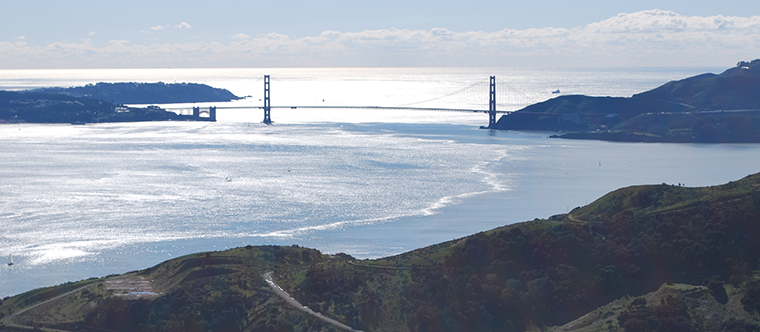The other day I was driving north on the I-880 flyover that connects Oakland and Berkeley. As I reached its highest point-just before it curves back to the north and begins its descent to ground level-I had a wonderful view of San Francisco Bay.

Using Tidal Current Tables to determine when and which direction to sail can make everything easier, faster, safer and more comfortable. Photo by Joel Williams
BY CAPTAIN RAY
Published: May, 2017
The other day I was driving north on the I-880 flyover that connects Oakland and Berkeley. As I reached its highest point—just before it curves back to the north and begins its descent to ground level—I had a wonderful view of San Francisco Bay. It was midmorning, the traffic was very light and the sun was behind me, making it possible to take a moment (I was driving after all!) to enjoy seeing the entire Central Bay spread out below me. As I took it all in, I realized once again that a sail around the Central Bay is one of the great daysails in the world.
The “right” way to sail around the Central Bay is counter-clockwise. This means sailing south in front of the Golden Gate Bridge (from the Sausalito side to the San Francisco side), then east along the city front (from Crissy Field toward Pier 39), and west through Raccoon Strait (from Tiburon to Sausalito). The reason for this comes from the prevailing wind on San Francisco Bay, which blows in the Golden Gate. A counter-clockwise route has us sailing with the wind where it is strongest and working our way upwind in the somewhat protected waters of Raccoon Strait.
You can, of course, begin at any point in this circuit. Richmond, Sausalito, the San Francisco Marina, Pier 39 Marina, South Beach Harbor and the marinas in the Oakland Estuary, Emeryville and Berkeley all provide easy access. Your stating point and tidal current calculations will be determined by where your boat is. Let me give you a few examples:
I sail out of Berkeley, so this plan is based on starting there. I want to time my departure so that the current in Raccoon Strait is ebbing (flowing southwesterly, toward the Golden Gate) while I am sailing on those waters. However, when I reach the Golden Gate and want to sail east (toward Pier 39), I want the current to be flooding (flowing east, into the Bay). I estimate that bit will take 90 minutes to two hours to sail from Berkeley, through Raccoon Strait, and up to the Golden Gate Bridge. Therefore, I need to depart Berkeley about two hours before the current is due to switch from ebb to flood. All that remains is to consult the Tidal Current Tables and find a day when that change happens at a convenient hour.
On the other hand, suppose I was sailing out of the San Francisco Marina. In that case, I would want to depart while the current is flooding and allow it to carry me past Pier 39 and Alcatraz. Then (if I timed things properly), as I rounded Angel Island and began to sail westward, the current would switch to the ebb and I could ride it back toward the Golden Gate Bridge. It will only take about 30 minutes to get past Alcatraz from Crissy Field. So, it’s just a matter of selecting a day when that change happens at a time I want be out sailing.
While you could do this sail at any time, it is much more pleasant (and for me, personally more satisfying) to schedule the sail in order to take advantage of the tidal currents that keep the Bay waters moving. When timed correctly, you will find everything is easier, faster, safer and more comfortable. Sailing against the current can be even more unproductive than sailing into the wind. (Think of walking the wrong way on a people mover at the airport. It take a lot of energy to achieve small results.)
I can remember trying to sail west in Raccoon Strait (the water that separates Angel Island from Tiburon) against both the flood current and the west wind and making absolutely no progress. That experience certainly drove home for me the futility of arguing with—and the pleasure of cooperating with—Mother Nature.
Ray Wichmann is a US SAILING-certified Ocean Passagemaking Instructor, a US SAILING Master Instructor Trainer, and a member of US SAILING’s National Faculty. He holds a 100-Ton Master’s License, was a charter skipper in Hawai’i for 15 years, and has sailed on both coasts of the United States, in Mexico, the Caribbean and Greece. He is presently employed as the Master Instructor at OCSC Sailing in the Berkeley Marina.

